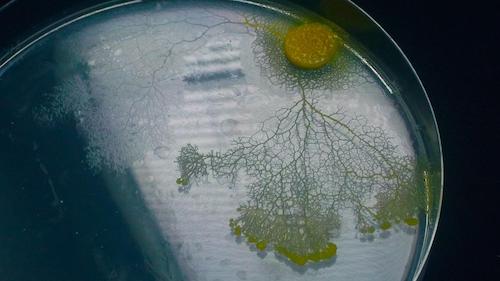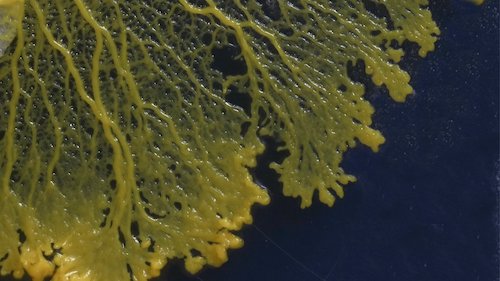Communiqué
Brainless blobs that can make decisions on NOVA “Secret Mind of Slime” – March 23 at 9 pm
< < Back to brainless-blobs-that-can-make-decisions-on-nova-secret-mind-of-slime-march-23-at-9-pmMeet slime molds: brainless blobs that can learn, make decisions, and navigate mazes!
NOVA: Secret Mind of Slime
Wednesday, March 23 at 9 pm
NOVA “Secret Mind Of Slime” dives deep into the questions and science behind the “intelligence” of slime molds. These creatures are not animals, nor plants, nor fungi, yet they appear to learn and to make decisions without brains, expanding the boundaries of intelligence beyond the animal kingdom
The film follows scientists as they delve into the questions of how these organisms “think” and “make decisions.” Focusing on Physarum polycephalum, an electric-yellow slime mold, scientists study how they navigate mazes, choose between foods, and create vein networks that distribute food to different parts of the mold — all without a brain.
 The yellow blob-like shapeshifting substance is a single-celled organism whose learning capacity has scientists closely examining the roots of cognition.
The yellow blob-like shapeshifting substance is a single-celled organism whose learning capacity has scientists closely examining the roots of cognition.
The film also joins Associate Professor Tanya Latty (University of Sydney), Professor Toshiyuki Nakagaki (Hokkaido University), and CNRS Researcher Audrey Dussutour as they explore how the slime mold seems to make choices, solve complex problems, and devise strategies.
Throughout the special, we watch these studies come to life as scientists push Physarum to its limit, testing its ability to find food, determine the most nutritious sustenance, reform itself, establish memory, and create optimal networks.
When put to the test, Physarum is even capable of recreating an optimal network similar to the Tokyo metro system. Without a brain or nervous system, the slime mold performs all the fundamentals of intelligence. Ultimately, this leaves scientists considering how we define intelligence and pondering whether intelligent life even requires the presence of a brain.
For centuries, intelligence — or the ability to reason and think — was thought to be a trait unique to humans. However, research over the last century has established that other living things possess what might be considered cognitive abilities.Since Darwin’s time, there has been speculation about such abilities in plants. Darwin himself believed that plants possessed a kind of cognitive function in their root tips.
On “Secret Mind Of Slime,” Italian scientists Stefano Mancuso and Frantisek Baluska conduct studies on the roots of plants and find that root tips are able to sense underground obstacles like rocks and can coordinate with the rest of the plant to forge the optimal pathway.
 Upon study, they determine that plants are able to “remember” different stimuli, differentiating between those that are dangerous and those that are not, and respond accordingly.
Upon study, they determine that plants are able to “remember” different stimuli, differentiating between those that are dangerous and those that are not, and respond accordingly.
Physarum revealed similar signs of learning. This slime mold, referred to as “the Blob,” does not like salt, so scientists test whether it will cross a short salt-coated bridge to reach food, testing the slime mold’s ability to learn and adapt.
Over time the Blob learns to overcome the challenge of the salt and is able to cross the salt bridge more efficiently — exhibiting its ability to alter behavior through past experiences.
“Secret Mind Of Slime,” pushes scientists and viewers to reconsider the origins of intelligence. The film follows Professor and Director of the Allen Discovery Center at Tufts University, Michael Levin, and his team, who investigate evidence of cells communicating via bioelectricity in various organisms including Physarum.
This type of communication without neurons is likely descended from one of the earliest stages of evolution, an ancient forerunner of what would eventually emerge as the more complex intelligence of creatures such as humans.

